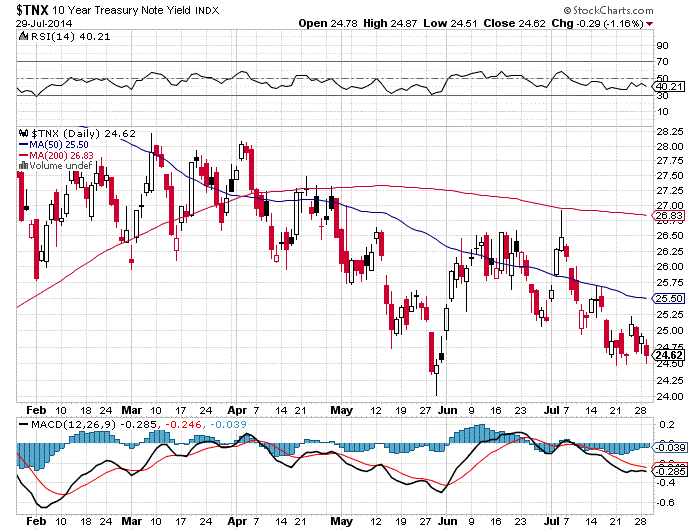A funny thing happened on the way to higher interest rates: yields took a surprising turn lower. The 10-Year Treasury yield yesterday dipped under 2.47%, near the lowest level since a swoon in late-May pushed this benchmark rate to an intraday low of roughly 2.40% at one point. There are several explanations making the rounds for the current decline in the price of money: Rising anxiety over escalating tensions with the Russia-Ukraine crisis by way of a new phase of US and European sanctions; worries that the Eurozone’s feeble recovery is deteriorating again; concerns that the US economy’s housing sector is in trouble, perhaps with ramifications for the broader economy down the road. Whatever the cause, the crowd’s appetite for bonds is on the rise again.
Mark Hulbert at MarketWatch speculates that the “10-year Treasury could yield 4% by Thanksgiving.” The renewed demand for the relative safety of government debt isn’t limited to US bonds. As Bloomberg reported yesterday, German bonds “have joined a rally that’s swept borrowing costs to record lows across the euro area.” The descent in yield convinces Jeremy Warner at The Telegraph that
European bond yields are once again on depression alert – and this time it is not just German bunds which are signalling an economic contraction to come. The Spanish ten year bond yield has fallen to its lowest level since the French revolution in 1789; it’s a similar story elsewhere in the eurozone.
Last week I noted that “the Case For Higher Rates Looks Weak… Again,” and the recent momentum suggests there’s no reason to change that view today. Some analysts attribute part of the revived demand for bonds to the next round of easing due via the European Central Bank’s previously announced rollout of new loans to banks in the Eurozone. “‘Don’t fight the Fed’ has become ‘don’t fight the ECB’,” Iain Stealey, a portfolio manager at J.P. Morgan Asset Management, told The Wall Street Journal yesterday. “We’ve got another round of easing on the way in September and December. That liquidity will continue to fuel a grab for yield across all euro-zone bonds.”

A jump in geopolitical risk only adds to the allure of fixed income. “There is definitely a risk of a blowback into the European economy [from Russian sanctions] and that is why Bunds are rallying,” advises Alastair Thomas, head of rates and treasury management at ECM Asset Management, in the Journal article noted above.
Just to keep things interesting, the Federal Reserve is scheduled to issue a statement later today on monetary policy. Expectations are widespread that the Fed will announce that it will continue to wind down its economic stimulus and thereby lay the groundwork for raising interest rates down the road. But for the moment, Mr. Market has other things on his mind. Higher rates are a positive if, as the IMF’s Hamid Faruqee reminds, the hikes are accompanied by stronger growth. “The road ahead is a tricky one,” he warns. “Much will depend on how well the normalization process can be managed. That is, how smoothly can we transition along a path to higher growth and interest rates?”
Judging by recent history, the road to normalization has taken a detour on a bumpy side road, at least for now. The main uncertainty is whether this is a temporary diversion or the start of alternative scenario that threatens to change the big-picture game plan. For now, the economic data for the US is encouraging, although the mixed data on housing could be a spoiler. Nonetheless, Friday’s payrolls report from the Labor Department is widely expected to bring another dose of upbeat numbers. As such, the recent past is on track to impress the crowd. As usual, however, it’s the future that will keep us guessing, and perhaps more so than we’ve become accustomed to lately.
